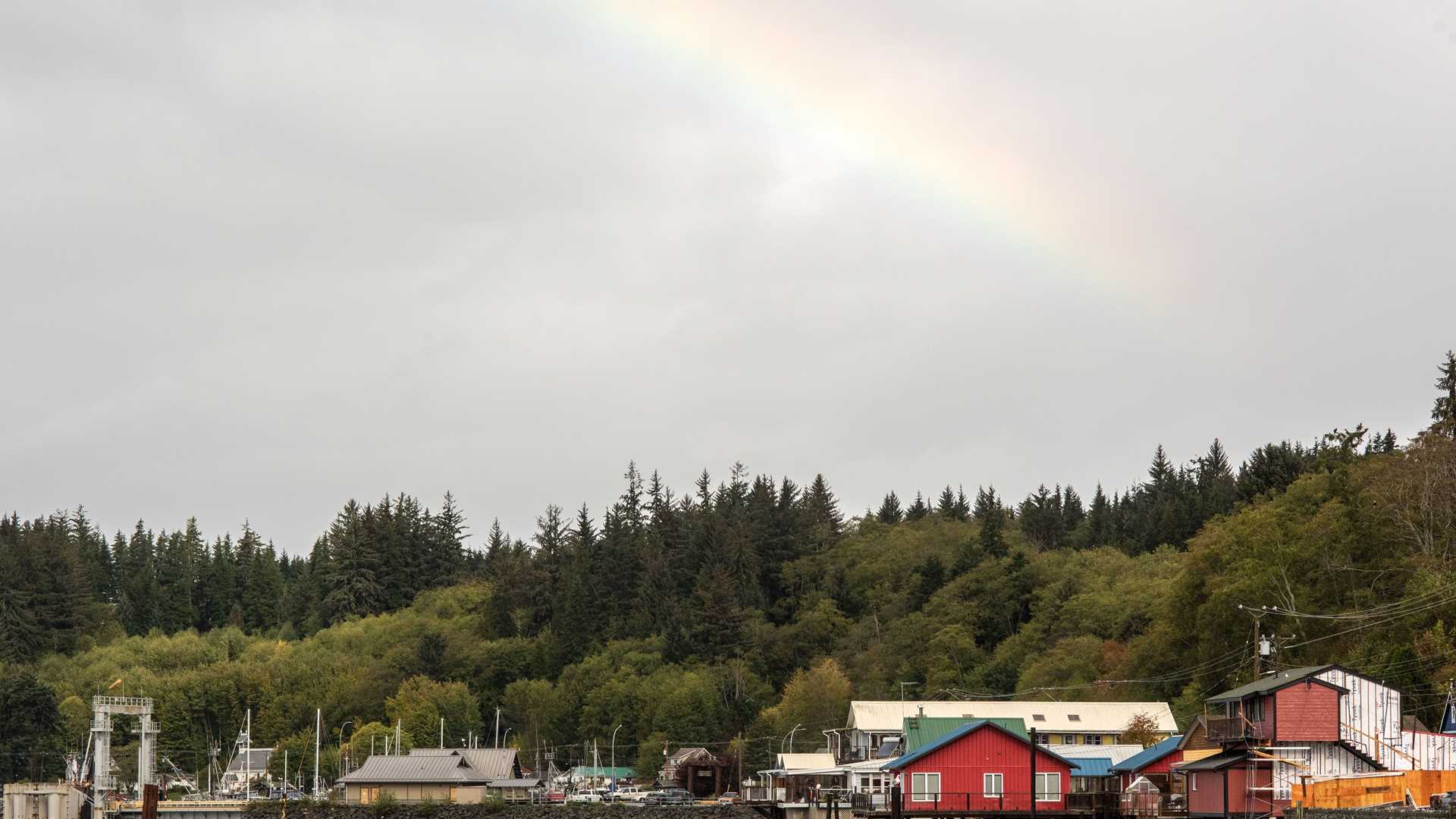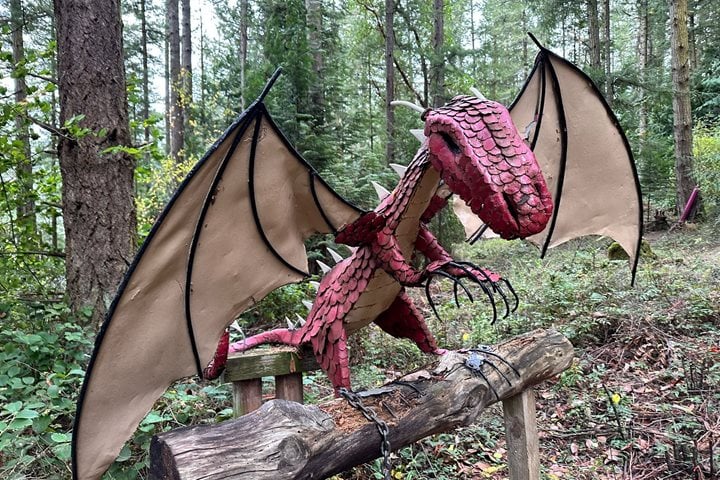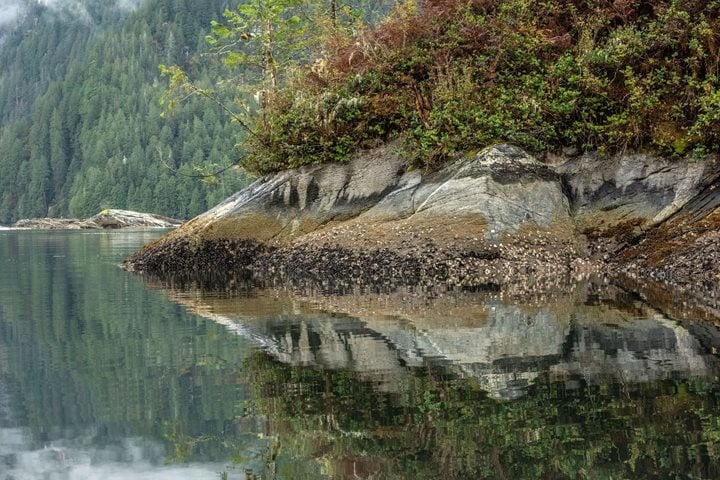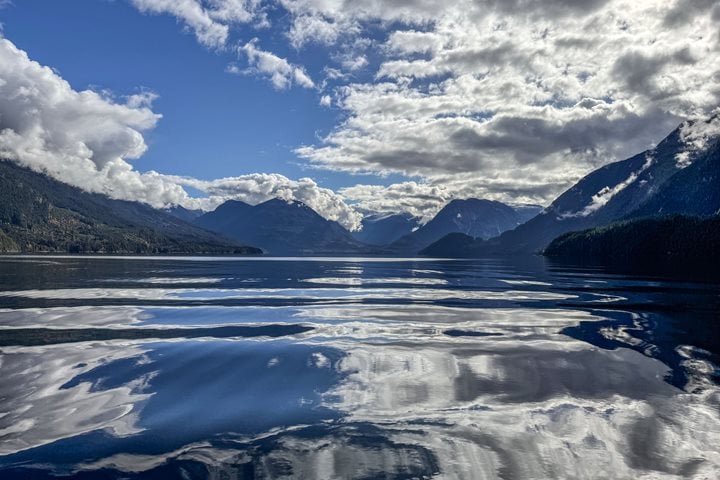At first light today, National Geographic Venture continued cruising north in high winds and heavy rain. Fall weather was with us today. Due to the forecast and the northern destination of Alert Bay, we had a rare opportunity to sleep in and enjoy an early brunch while our vessel continued her journey north.
At approximately 10:30 am, the ship was on approach to Cormorant Island and the community of Alert Bay. As our bridge staff slowed the ship’s approach, it became obvious that trying to tie up to the dock would not be possible due to high winds. Anchoring would be necessary. After anchoring and dropping Zodiacs, announcements were made, and our group was called to the mudroom for departure to Government Dock in Alert Bay. Once on shore, we all checked in with Alert Bay security. Due to rain, we were able to store our life jackets inside a net shed located on Government Dock.
After everyone made it ashore by Zodiac, we all gathered near the end of Government Dock and either walked or took a small bus provided by the U’mista Cultural Center, which was our first stop of the day! Inside, we divided into two groups. First, we were invited to watch a film on the Potlatch by Barbara Cranmer.
“The Kwakwaka’wakw believe that animals, rivers, and trees are powerful beings that long ago existed in both the human world and the spirit world. The Kwakwaka’wakw coexisted with these ancestral beings and came to be related to certain animal spirits such as the salmon. The Kwakwaka’wakw believe that their wealth, which comes from their surroundings, is a result of their connection to the spirit beings. It is through the Potlatch—an elaborate gift giving and feasting ceremony—that they offer thanks to the ancestral spirits for their generosity, share their riches, and celebrate family ties.”-Barbara Cranmer
Once the rest of our group arrived, the second half of the group went into the depths of the Cultural Center to view a repatriated collection of regalia. A Potlatch was raided in 1921 by the Canadian Mounties on Village Island, and the Canadian government confiscated all the regalia. Some years later, the Namgis people of Alert Bay petitioned the Canadian government to return their regalia. The response from the Canadian government was, “If you build a museum, we will bring your regalia home…” And so the U’mista Cultural Center was built in the early 1980s. Elders in the community of Alert Bay often call this center a “Box of Treasures.”
Our day was only half complete, and our next stop was the Big House. Either by van or by foot, we all made our way a short distance to a traditional Kwakwaka’wakw Big House where the T’sasata Cultural Group hosted cultural sharing with everyone from the ship. A large fire was roaring in the center of the Big House. Elder Vera Newman greeted everyone who entered and spent time sharing stories with many of us as we took seats on one side of the Big House. During the next hour, we were treated to several dances that are customarily shared during a Potlatch. As our host Andrea Cranmer explained, we were just touching on a small sampling of what it would be like to sit in the Big House with 1,200 people to experience the wealth and richness of Kwakwaka’wakw Culture. The final treat was a chance to participate in a fun dance. After the hosting chief finishes sharing his box of treasures during a Potlatch, everyone is invited onto the floor of the Big House to dance! And so, many of our group danced with our hosts around the central fire, celebrating the opportunity to share in a Living Culture.
All too soon, it was time to return to National Geographic Venture and continue our journey to other parts of the Salish Sea and the Pacific Northwest. Once we were back on the ship, we headed south. We were scheduled for a specific time, slack water, to pass through Seymour Narrows. On the way, we had a short time to explore Blackfish Sound, a location known for marine mammals and seabirds. Upwelling currents provide a phenomenal food source for a myriad of birds and animals. The wind was still quite strong, which called for careful maneuvering by our bridge officers. We spotted several humpback whales and many seabirds taking advantage of the food available just below the surface of the sea.
Keeping on schedule for our appointment at Seymour Narrows, National Geographic Venture continued her journey south in Johnstone Strait. Naturalist David presented in the lounge on his many years collecting data on killer whales in Blackfish Sound.
It was a full day! Fall brings much shorter days, and as the light dimmed at sunset, it was time for our evening recap. We recounted many stories of our memorable day as guests of the Namgis peoples and the Kwakwaka’wakw Nation. Walking back through the community of Alert Bay to Government Dock, there was much conversation about the extraordinary experience of a “Living Culture.” One of our traveling companions, Allan Lohaus, had given much thought to how he was feeling after witnessing such depth of passion expressed in a culture that has seen thousands of years. He said, after reflecting, “Being is the now of becoming.”







